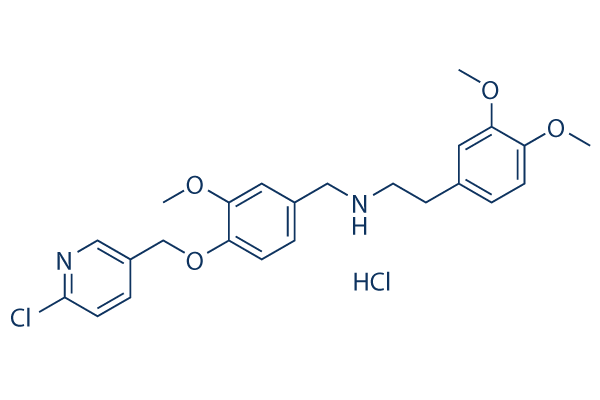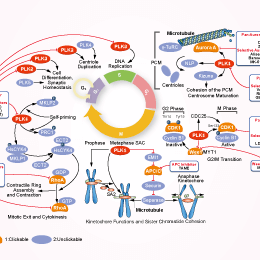
- Bioactive Compounds
- By Signaling Pathways
- PI3K/Akt/mTOR
- Epigenetics
- Methylation
- Immunology & Inflammation
- Protein Tyrosine Kinase
- Angiogenesis
- Apoptosis
- Autophagy
- ER stress & UPR
- JAK/STAT
- MAPK
- Cytoskeletal Signaling
- Cell Cycle
- TGF-beta/Smad
- DNA Damage/DNA Repair
- Compound Libraries
- Popular Compound Libraries
- Customize Library
- Clinical and FDA-approved Related
- Bioactive Compound Libraries
- Inhibitor Related
- Natural Product Related
- Metabolism Related
- Cell Death Related
- By Signaling Pathway
- By Disease
- Anti-infection and Antiviral Related
- Neuronal and Immunology Related
- Fragment and Covalent Related
- FDA-approved Drug Library
- FDA-approved & Passed Phase I Drug Library
- Preclinical/Clinical Compound Library
- Bioactive Compound Library-I
- Bioactive Compound Library-Ⅱ
- Kinase Inhibitor Library
- Express-Pick Library
- Natural Product Library
- Human Endogenous Metabolite Compound Library
- Alkaloid Compound LibraryNew
- Angiogenesis Related compound Library
- Anti-Aging Compound Library
- Anti-alzheimer Disease Compound Library
- Antibiotics compound Library
- Anti-cancer Compound Library
- Anti-cancer Compound Library-Ⅱ
- Anti-cancer Metabolism Compound Library
- Anti-Cardiovascular Disease Compound Library
- Anti-diabetic Compound Library
- Anti-infection Compound Library
- Antioxidant Compound Library
- Anti-parasitic Compound Library
- Antiviral Compound Library
- Apoptosis Compound Library
- Autophagy Compound Library
- Calcium Channel Blocker LibraryNew
- Cambridge Cancer Compound Library
- Carbohydrate Metabolism Compound LibraryNew
- Cell Cycle compound library
- CNS-Penetrant Compound Library
- Covalent Inhibitor Library
- Cytokine Inhibitor LibraryNew
- Cytoskeletal Signaling Pathway Compound Library
- DNA Damage/DNA Repair compound Library
- Drug-like Compound Library
- Endoplasmic Reticulum Stress Compound Library
- Epigenetics Compound Library
- Exosome Secretion Related Compound LibraryNew
- FDA-approved Anticancer Drug LibraryNew
- Ferroptosis Compound Library
- Flavonoid Compound Library
- Fragment Library
- Glutamine Metabolism Compound Library
- Glycolysis Compound Library
- GPCR Compound Library
- Gut Microbial Metabolite Library
- HIF-1 Signaling Pathway Compound Library
- Highly Selective Inhibitor Library
- Histone modification compound library
- HTS Library for Drug Discovery
- Human Hormone Related Compound LibraryNew
- Human Transcription Factor Compound LibraryNew
- Immunology/Inflammation Compound Library
- Inhibitor Library
- Ion Channel Ligand Library
- JAK/STAT compound library
- Lipid Metabolism Compound LibraryNew
- Macrocyclic Compound Library
- MAPK Inhibitor Library
- Medicine Food Homology Compound Library
- Metabolism Compound Library
- Methylation Compound Library
- Mouse Metabolite Compound LibraryNew
- Natural Organic Compound Library
- Neuronal Signaling Compound Library
- NF-κB Signaling Compound Library
- Nucleoside Analogue Library
- Obesity Compound Library
- Oxidative Stress Compound LibraryNew
- Plant Extract Library
- Phenotypic Screening Library
- PI3K/Akt Inhibitor Library
- Protease Inhibitor Library
- Protein-protein Interaction Inhibitor Library
- Pyroptosis Compound Library
- Small Molecule Immuno-Oncology Compound Library
- Mitochondria-Targeted Compound LibraryNew
- Stem Cell Differentiation Compound LibraryNew
- Stem Cell Signaling Compound Library
- Natural Phenol Compound LibraryNew
- Natural Terpenoid Compound LibraryNew
- TGF-beta/Smad compound library
- Traditional Chinese Medicine Library
- Tyrosine Kinase Inhibitor Library
- Ubiquitination Compound Library
-
Cherry Picking
You can personalize your library with chemicals from within Selleck's inventory. Build the right library for your research endeavors by choosing from compounds in all of our available libraries.
Please contact us at info@selleckchem.com to customize your library.
You could select:
- Antibodies
- Bioreagents
- qPCR
- 2x SYBR Green qPCR Master Mix
- 2x SYBR Green qPCR Master Mix(Low ROX)
- 2x SYBR Green qPCR Master Mix(High ROX)
- Protein Assay
- Protein A/G Magnetic Beads for IP
- Anti-Flag magnetic beads
- Anti-Flag Affinity Gel
- Anti-Myc magnetic beads
- Anti-HA magnetic beads
- Poly DYKDDDDK Tag Peptide lyophilized powder
- Protease Inhibitor Cocktail
- Protease Inhibitor Cocktail (EDTA-Free, 100X in DMSO)
- Phosphatase Inhibitor Cocktail (2 Tubes, 100X)
- Cell Biology
- Cell Counting Kit-8 (CCK-8)
- Animal Experiment
- Mouse Direct PCR Kit (For Genotyping)
- New Products
- Contact Us
SBE 13 HCl
PLK inhibitor
research use only
SBE 13 HCl is a potent and selective PLK1 inhibitor with IC50 of 200 pM, >4000-fold selectivity over Aurora A kinase, Plk2 and Plk3.

Chemical Structure
Molecular Weight: 479.4
Purity & Quality Control
Related Products
| Related Targets | PLK1 PLK2 PLK3 PLK4 | Click to Expand |
|---|---|---|
| Related Products | BI 2536 Volasertib Rigosertib (ON-01910) GSK461364 Onvansertib (NMS-P937) Ro3280 CFI-400945 HMN-214 MLN0905 Poloxin | Click to Expand |
| Related Compound Libraries | Kinase Inhibitor Library PI3K/Akt Inhibitor Library MAPK Inhibitor Library DNA Damage/DNA Repair compound Library Cell Cycle compound library | Click to Expand |
Signaling Pathway
Mechanism of Action
| Targets |
|
|---|
In vitro |
||||
| In vitro | SBE 13 decreases cell proliferation in various cancer cell lines, and causes a G2/M arrest followed by apoptosis. [1] In primary cells, SBE 13 does not impair cell cycle and thus proliferation of primary cells. [2] SBE13 in combination with Enzastaurin displays a synergistic reduction of cell proliferation and enhanced apoptosis induction in HCT116(p53-/-) cells. [3] | |||
|---|---|---|---|---|
| Kinase Assay | Kinase assays | |||
| To assay Plk1 and Aurora A kinase activity, cells are lysed after 13 hrs release in the presence of SBE13 after double thymidine block, and kinases are immunoprecipitated from lysates using antibodies as described. In brief, for each immunoprecipitation 800 µg of total protein were incubated with 1.5 µg Plk1 antibody cocktail, 3 µg Plk2 antibody, 3 µg Plk3 antibody, or 5 µg Aurora A antibody, respectively, for 2 hrs at 4°C on a rotator. Immunoprecipitated protein is collected using Protein G Agarose beads. The Plk1, Plk2 and Plk3 immunoprecipitates are incubated with 1 µg casein and with 1 µCi of [γ32-P]ATP for 30 min at 37°C in kinase buffer. The Aurora A immunoprecipitates are incubated with 0.5 µl Histone and with 1 µCi of [γ32-P]ATP for 60 min at room temperature in kinase buffer. Products from the kinase assays are fractionated on 10% Bis-Tris-polyacrylamide gels, and the phosphorylated substrate is visualized by autoradiography after an exposure of 12 to 36 hrs. An equal amount of immunoprecipitates is subjected to western blot analysis to confirm equal loading of Plk1, Plk2, Plk3 or Aurora A protein in kinase reactions. Immunoprecipitated Plk1 after 13 hrs release in the presence of SBE13 is assayed after de-phosphorylation using λ protein phosphatase and compared to kinase activity of endogenous immunoprecipitated Plk1. Activity of Plk1 kinase with and wiiiuithout de-phosphorylation is compared and the ratio between de-phosphorylated and “normal” endogenous immunoprecipitated Plk1 kinase activity is calculated. | ||||
| Cell Research | Cell lines | HeLa, A431, HCT-15, HT-29, MCF-7, U2OS, LN-229, SKW 6.4, PC-3, Det-562, SK-BR-3, SK-OV-3 and A549nb cells | ||
| Concentrations | 100 μM | |||
| Incubation Time | 72 hours | |||
| Method | Cells are treated with SBE13 one day after subculturing. Control cells are incubated with normal culture medium. Concentrations of SBE13 ranged from 1 nM–100 µM. The growth rate of 1 x 105 cells per 6-well is determined by counting cells at 24, 48 and 72 hours after treatment. Cell culture studies are performed in triplicate for each time point. | |||
References |
|
Chemical Information
| Molecular Weight | 479.4 | Formula | C24H28Cl2N2O4 |
| CAS No. | 1052532-15-6 | SDF | Download SDF |
| Synonyms | N/A | ||
| Smiles | COC1=C(C=C(C=C1)CCNCC2=CC(=C(C=C2)OCC3=CN=C(C=C3)Cl)OC)OC.Cl | ||
Storage and Stability
| Storage (From the date of receipt) | |||
|
In vitro |
DMSO : 95 mg/mL ( (198.16 mM) Moisture-absorbing DMSO reduces solubility. Please use fresh DMSO.) Water : Insoluble Ethanol : Insoluble |
Molecular Weight Calculator |
|
In vivo Add solvents to the product individually and in order. |
In vivo Formulation Calculator |
|||||
Preparing Stock Solutions
Molarity Calculator
In vivo Formulation Calculator (Clear solution)
Step 1: Enter information below (Recommended: An additional animal making an allowance for loss during the experiment)
mg/kg
g
μL
Step 2: Enter the in vivo formulation (This is only the calculator, not formulation. Please contact us first if there is no in vivo formulation at the solubility Section.)
% DMSO
%
% Tween 80
% ddH2O
%DMSO
%
Calculation results:
Working concentration: mg/ml;
Method for preparing DMSO master liquid: mg drug pre-dissolved in μL DMSO ( Master liquid concentration mg/mL, Please contact us first if the concentration exceeds the DMSO solubility of the batch of drug. )
Method for preparing in vivo formulation: Take μL DMSO master liquid, next addμL PEG300, mix and clarify, next addμL Tween 80, mix and clarify, next add μL ddH2O, mix and clarify.
Method for preparing in vivo formulation: Take μL DMSO master liquid, next add μL Corn oil, mix and clarify.
Note: 1. Please make sure the liquid is clear before adding the next solvent.
2. Be sure to add the solvent(s) in order. You must ensure that the solution obtained, in the previous addition, is a clear solution before proceeding to add the next solvent. Physical methods such
as vortex, ultrasound or hot water bath can be used to aid dissolving.
Tech Support
Answers to questions you may have can be found in the inhibitor handling instructions. Topics include how to prepare stock solutions, how to store inhibitors, and issues that need special attention for cell-based assays and animal experiments.
Tel: +1-832-582-8158 Ext:3
If you have any other enquiries, please leave a message.
* Indicates a Required Field






































